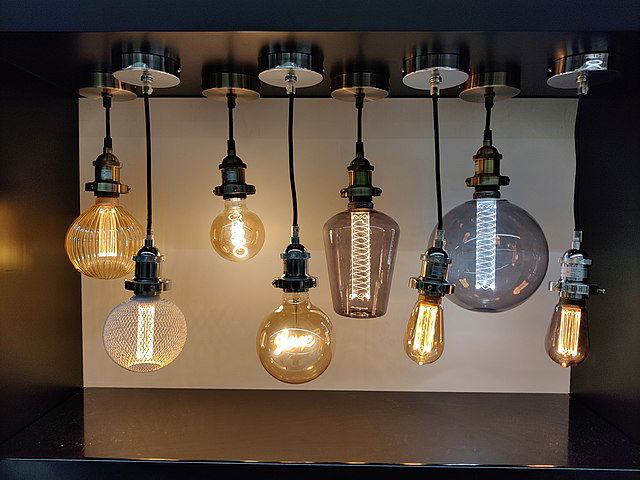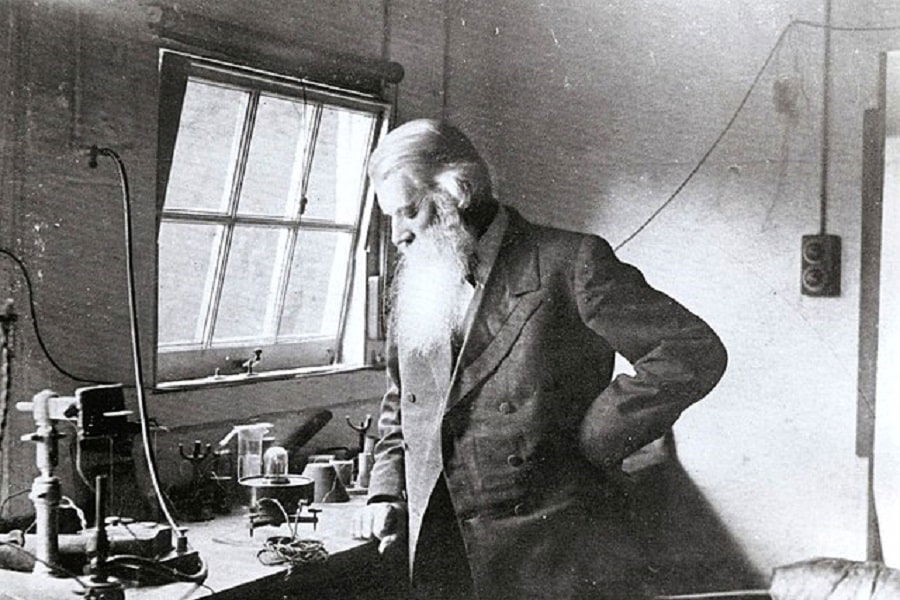It is a common scientific myth that Thomas Edison invented the lightbulb. After all, he was known for inventing many great devices and perfecting hundreds more. Edison’s companies not only mass-produced electric lights but created the power stations that lit up cities.
Science, however, is about facts, not mythology. The fact is that, despite the help he gave to bring electric light to the homes of hundreds of thousands, it wasn’t Thomas Edison who invented the lightbulb after all.
Table of Contents
Who Invented The Lightbulb?

The very first light bulb was not invented by Thomas Edison, but by British inventor Humphry Davy in 1806. His devices created an arc of electricity between electrodes, creating a very bright light. While far too dangerous to use at home, they were used in public spaces and commercially.
READ MORE: The First Camera
The First Incandescent Light Bulb
The incandescent light bulb, using a filament inside a glass bulb, has a complex history. Belgian inventor Marcellin Jobard experimented with carbon filaments in vacuum tubes as early as 1838 and, before Thomas Edison examined the technology, other inventors were hard at work on their own devices. These men included Warren de la Rue, whose platinum design held the record for longevity for decades, and Jean-Eugène Robert-Houdin, the French Illusionist now recognized as the father of modern magic.
The First Practical Light Bulb
The first commercial light bulb was created by Joseph Swan in 1860. His bulb, which used a carbon filament within an evacuated glass bulb, did not last very long due to his inability to create a proper vacuum. Later experiments had more success. Swan’s home was the first house in the world to be lit by light bulbs, and in 1881 his devices lit the Savoy Theatre in Westminster.
In 1874, Canadian electricians Henry Woodward and Matthew Evans also patented a light bulb. Their attempts at commercialization failed, however, and they eventually sold their design to Edison.
Thomas Edison’s light bulb was patented in 1878, though his first successful design wasn’t until the year after. It lasted thirteen hours. Through experiments and careful examination of other patents around the world, Edison found better filaments to use and perfected the vacuum required. After discovering that a carbonized bamboo filament could burn for over a thousand hours, Edison was able to produce a commercially viable light bulb.
Thomas Edison established the “Edison Electric Light Company” in 1878 but was sued by Joseph Swan’s “United Electric Light Company” in British courts. They decided in Swan’s favor. Edison filed suit against Swan in America in return, and so began what could have been an expensive legal battle. To solve the problem that may have destroyed both men, the two inventors merged their companies in 1883. This new company soon became the largest manufacturer of bulbs in the world.

Who Discovered Incandescent Light?
Italian inventor Alessandro Volta is better known as the man who invented the modern battery. However, among his other great inventions and discoveries was the concept of incandescent light.
Volta’s Incandescent Wire
Volta’s battery, which was designed and produced in 1800, was made of discs of copper and zinc, separated by cardboard soaked in brine. When a copper wire was connected to either end of this “voltaic pile,” electricity would pass along it. When experimenting with this primitive form of battery, Volta discovered that a thin enough wire would produce heat and visible light, eventually degrading from the process. This would be considered the first incandescent light.
There is little evidence that Volta realized the possible applications of this phenomenon. He was far more interested in improving his battery and its ability to produce a sustained, regular current.
Humphry Davy’s “Electric Arc Lamp”
Excited by Volta’s experiments with batteries, Davy set to work immediately on creating an electric lamp. His 1815 invention used arcs of electricity between charcoal electrodes, protected by a thin sheet of gauze. Davy had invented his lamp specifically to offer bright lights that were safe for miners.
Humphry Davy was an English chemist who had previously made his name by discovering both sodium and potassium by using Volta’s battery in different salt solutions. Finding new technology for miners was important to many inventors, as open-flame lamps often caused massive tragedies. Gas pockets released within a mine could easily catch light from such lamps and sometimes killed close to a hundred men at a time.
The “Davy Arc Lamp” produced an intense light, and later versions were used in street lighting. However, these lamps were large, required great amounts of electricity, and were too complex for homes.

Joseph Swan, Inventor of the First Light Bulb?
If you searched today to find who invented the first light bulb, most sources would give the title to the English inventor Joseph Swan. It may be that he deserves it, as he did invent the first commercial electric lamp in 1860, and his design for incandescent lighting so inspired Thomas Edison that the two ended up in a major legal battle before eventually merging their companies.
Joseph Wilson Swan was a physicist and chemist who began his career as a pharmacist. In 1850 he began experimenting in his free time, passing an electric current through carbon filament, producing light.
Having read the experiments of other inventors around the world, he designed a light within a vacuum tube and began presenting his design around England. To create a vacuum, Swan has designed his own pump. However, he was never able to perfect this integral part of the component and his light bulbs never burned too long before going out.
Despite this failure, Swan’s design for an electric lamp was brilliant. So brilliant that when, in 1878, Edison read about his presentations, he immediately had his lab incorporate much of the work done by the Englishman. Edison’s eventual design was so similar to Swans, that lengthy legal battles occurred on both sides of the Atlantic before the men combined their companies and began to mass-produce the technology together.
READ MORE: The First Television Ever Made
Why Do People Think Thomas Edison Invented the Light Bulb?
While Edison may have been late to the party when it came to designing an electric light bulb, his knowledge of previous works and vast resources allowed him to improve the design immeasurably. By making bulbs that conformed to a design, and creating electricity networks that could be taken advantage of by their installation, the name Edison quickly became synonymous with the technology.
The Edison Labs
Thomas Alva Edison was an employee of Western Union when he began his experiments with electricity. By patenting the first electronic voting machine and creating the multiplex telegraph, which could send and receive multiple signals at once, Edison made a name for himself as an inventor. This system was a very large commercial success and allowed him to create an industrial lab in Menlo Park, New Jersey. The labs were devoted entirely to experimentation and production.
Thomas Edison’s company included the electrical engineer William Joseph Hammer, who is sometimes considered the co-creator of most of Edison’s greatest creations. Hammer eventually became the man in charge of testing the hundreds of electronic lamp prototypes while offering his considerable expertise to perfect the technology. Hammer later created the first major power station, which could power over 3000 lamps.

Edison’s Incandescent Bulb
Thomas Edison’s incandescent light bulb used a carbon or metal filament within a vacuum tube very similar to Joseph Swan’s. Because of the considerable resources of Edison’s company, he and Hammer did experiments with different gasses, a range of shapes and types of filaments, and even the shapes of the glass bulbs. More importantly, Edison’s lab was able to invest in more effective vacuum pumps, solving the problems Swan faced with his own electric light.
Eventually, the team settled on a carbon filament light bulb. While it wasn’t as effective as a platinum filament, carbon was cheap and far more effective than many of the other metals used by other inventors.
Once the team at the labs was happy with their design of a cost-effective, the long-lasting incandescent light bulb, the inventor quickly turned to mass production. Thomas Edison’s “Light Works” produced over fifty thousand electric lights in its first year, under the guidance of general manager Francis Upton.
The Edison Electric Illuminating Company
Part of the reason we associate Thomas Edison with lightbulbs had little to do with his design for the incandescent bulb. Instead, it was because he created a company that not only produced tens of thousands of light bulbs a year but created generating stations that could offer electric lighting for thousands of consumers.
The first electrical generating stations were built in London and then in New York. They were powered by coal and could provide power for thousands of lights, as well as for electric telegraphs around the cities.
The Death of Incandescent Light Bulbs
Thomas Edison’s light bulb design is quite similar to the electric lights of today. While the light bulb is now rounder, and tungsten filaments have replaced the original carbon ones, the general design and concept of function are the same.
However, the days of the incandescent light bulb might soon be over. The advent of LED lighting, which uses far less electricity and has decades of extra life span has made Edison’s technology obsolete.
While this may herald the end of incandescent bulbs, their legacy will be felt for a long time to come. The Edison Light Company would eventually become General Electric, one of the largest companies in America today. Thomas Edison may not be able to claim all the credit for the first electric light, but his determination to perfect the designs of Joseph Swan, Matthew Evens, and Warren De La Rue, and his creation of powerful stations to power the electric lights of entire cities, will forever connect him to this important invention.

The Strange Etymology of “The Light Bulb”
One anomaly in the history of the light bulb is that Thomas Edison never technically designed one at all. At least, that is not what he called the devices his labs made. For each inventor before him, light bulbs were instead referred to as “electric lamps” or “electric lights.”
The first time the term “light bulb” was used can be found in American Patent 330,139, which was for a laryngoscope (a device used to see down the throat of a medical patient.) In this 1885 patent, the inventor C.W. Meyer describes the bulb of the device as a “lamp bulb” many times, but also, for the first time in written history, a “light bulb.” The term included the use of a hyphen, rather than being two words, or the portmanteau it would sometimes be later used as.
Could it be, in a strange twist, that it was C.W Meyer who invented the “lightbulb?” If you were to look at it in a very strange light, you might be able to argue it was.
Is It a “Light Bulb” or “Lightbulb?”
While Meyer’s first use of the term in 1885 used a hyphen, people today often ask “is it a light bulb or lightbulb?” According to the Merriam-Webster dictionary, both are acceptable, but British dictionaries firmly insist that it is two words. Most modern style guides suggest using the words separately, but the most important thing is to be consistent.
Like many great advancements in technology, the light bulb wasn’t a single invention but a series of developments that occurred over decades. No, Thomas Edison was not the inventor, as much as history likes to think of him that way. Joseph Swan produced the first commercial electric light, and decades earlier Volta discovered incandescent light. Still, if it wasn’t for the Edison labs, and the Edison Electric Light Company producing tens of thousands of devices, perhaps it might have been decades until homes ever saw the benefits of the invention.